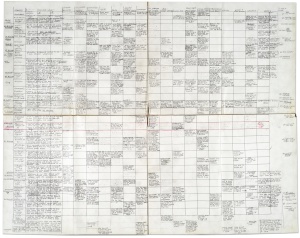
Joseph Heller’s plan for Catch-22. This was an enormous novel, though – a novella plan might be more concise.
Plan, plan, plan
Many writers think that because of their length, novellas are something they can just sit down and write. This is not the case. As with the novella’s longer cousin, the novel, it needs to be planned thoroughly beforehand.. What’s the point of writing ten thousand words only to realise the story has reached its conclusion? Forward planning using any stimulus such as the snowflake method or a simple brainstorm can make the difference between a novella and another short story.
Describe your novella in one sentence
Novellas have simple plots and minimal characters. If it is not possible to describe this in a single sentence, the idea will likely become a full-blown novel when written. The key aspects of a novella are its simple plot and few central characters. If the plot can’t be described in a sentence, the idea may be suited more for a novel than a novella.
Start with conflict
Creating a conflict in the first few pages of a novella will draw in the reader and encourage them to continue reading. This could be anything from a battle of life and death or something going missing. Create a conflict that the character must face early on and the reader will be enticed to find out how this conflict is resolved, if at all.
Consider writing in the first person
It’s important to create an instant connection between the main character in the novella and the reader. This will further encourage the reader to carry on reading as they develop a working relationship with the hero or heroine – this is much easier to accomplish through first person point of view than third.
Minimise number of characters and settings
Incorporating a large number of characters would not allow for a lot of character development in the smaller number of words a novella demands. Using a few key characters allows for full personalities to be made. The same can be said for settings as there are not enough words to write long, detailed descriptions of settings. Simple settings must be used to greater effect within a novella.
Avoid too many (or any) subplots
Novellas tend to circulate around one key plot and very rarely have more than one subplot. There is not enough time to wrap up a large number of smaller stories; one event, one problem, must be the centre of the novella’s attention.
Increase the pace
In a novel, the writer has time to drag out events, describe smaller detail and focus on less important sections of the narrative. This is not possible in a novella. To keep the word count small and the reader engaged, the pace must be quick. Long, drawn out scenes will push the novella towards novel status.
Keep it fluid
Due to their length, novels can afford to have stops and starts in the forms of Parts, Acts, or Chapters, with time gaps, shifts in perspective or rises and falls in dramatic tension. Due to their length, novellas can’t afford to do this – so keeping one strong central story thread, and keeping it fluid, is vital.
Revise, revise, revise
No one can be expected to throw out 20,000 to 40,000 words of an excellent novella, especially if the writer hasn’t published anything beforehand. The likelihood is that there will be a surplus of useless description and meaningless characters. Revision will allow for redundant elements to be cut out, leaving a more concise and streamlined novella.
Relax and have fun!
Writing doesn’t have to be stressful. It is often something that many choose to do for pleasure. A novella is much shorter than a novel, so it requires a lot less work, and usually a lot less revision too. Often it can be a great starting point for writers experimenting with the longer forms of fiction.